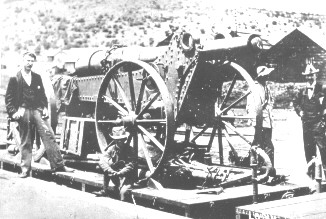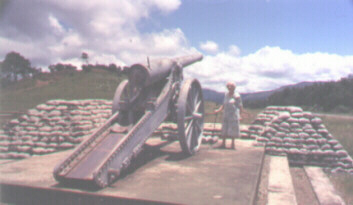Heavy Boer Artillery
"Waar kry jul die ou vrou?
Dan seg ons die ou Lady
Is �n nuwejaarspresent
Wat Ben Viljoen gestuur het
Vir ons ou President"
Translation: "Where did you get this old woman? Then we answer: 'It is a New year's present, which Ben Viljoen has sent to our old President'"
Words of a popular folk song called "Die Lady Roberts," written by F.W. Reitz while on commando. The Lady Roberts was the name of a British naval gun which was captured by general Ben Viljoen near Helvetia.
________________________________
The Formidable "Long Tom"

The Transvaal possessed four of these monster siege guns. The Boers dragged them afield, despite the fact that they had been considered to be far to heavy to be used outside of permanent emplacements. The replica above can be seen in front of the town hall in Ladysmith, Natal.

All four Long Toms were eventually destroyed by the Boers in order to avoid them being captured by the British forces. This replica stands in front of the Town Hall of Ladysmith, Natal. The gun above is a replica which stands at Fort Schanskop, just outside Pretoria.

Long Tom replica at the Long Tom pass between Lydenburg and Sabie in the Eastern Transvaal. Note the size of the gun, relative to the size of a human.

Picture, presumably from an armaments catalogue supplied to the Transvaal Government before the outbreak of war.

Picture, presumably from an armaments catalogue supplied to the Transvaal Government before the outbreak of war.

What is interesting, is the fact that the barrels of the Long Tom siege guns actually had to be removed and secured further aft when these guns were transported. This usually had to be done with a large block-and-tackle. This gun fired a missile of 94 pound weight. The guns were also so large that each time they could be used, a wooden platform had to be built for them to stand on. They were never intended to be used in the field, and doing so was a logistical nightmare. A picture of a beautifully-constructed Long Tom model can be seen at http://www.palmersarmoury.co.za/ .
Picture of the remains of the Long Tom, knick-named "The Jew" (because of its shortened barrel) after it had been blown up by the Boers to prevent it falling into British hands.
75mm Creusot rapid-fire field gun

TAB 19217
Calibre: 75mm. This gun was often referred to as "die Franse kanon" -- or "the French gun." These were modern artillery pieces that were used by the Boer forces with considerable success. Note two interesting facts: Firstly, how low the barrel is carried above the ground, and secondly, the fact that the barrel was actually carried in the middle of the axle. This approach was something entirely new, but made for a gun which did not overturn so easily. It also made it possible for this gun to be very easily concealed and camouflaged.

Direct hit.

The gun was fairly light, which made it fast to on the move, and easy to handle or shift position during a battle. The gun itself weighed only 355 kg, and the gun with fully-loaded ammunition carriage, weighed 1.8 tons.
Shrapnel range: 6.2 kilometres.
Percussion range: 6,2 kilometres.

The 75mm Cruesot had an innovative new recoil system which tended to be problematic at times, and gunners complained that the ammunition did not always perform as desired. Nevertheless, it had important advantages and presented valuable service.


The 75 mm Creusot can always be identified by the fact that the barrel is carried right in between the two axles. Note the extremely low profile.
The famous "pom-pom" gun
The Nordenfelt-Maxim in 37mm calibre was the smallest piece of artillery that was used during the war -- and very often also one of the most successful. It was sometimes called an "Automatic Machine Gun." It fired shells of one pound in weight accurately over a distance of 3,000 yards. The barrel was water cooled, and the shells were belt-fed, 25 to a belt.

Boer gunners posing with their pom-pom. Picture taken at Mafeking in 1900. Note the raised shield in front which protected the gunners against snipers and frontal shrapnel. Photo source: National Archives, Pretoria.
The gun was light and fast to move, being only 1.3 tons with a fully-loaded ammunition carriage. The range was approximately 2.7 km.

This specimen can be seen at the War Museum in Johannesburg. The accompanying plaque says that it was used in South West Africa during WWI, but the design was essentially still the same at that time. A notable difference is the armour shield that the Boers fitted to their pom-poms during the Boer War. These shields were very valuable in protecting the guncrew, since pom-poms tended to attract a lot of infantry fire and shrapnel.

Photo taken at the War Museum in Johannesburg
The pom-pom proved to be a highly mobile weapon which had a particularly bad psychological effect on the enemy, since the shells could be fired very rapidly -- hence the name "pom-pom." The mechanism wasn't always extremely reliable, though, and the gun sometimes jammed during crucial moments. The cast-iron shells sometimes became wet under battle conditions and rusted. The rust had to be carefully polished off, and the gunners intensely disliked having to polish ammunition when they were in the heat of battle.
The pom-pom was initially thought to be inadequate by the British army. It soon soon learned from the Boer example, however, and placed orders until the guns were used very widely and with valuable effect.
Note that not all pom-poms had an armour shield in front. The shield proved to be of great value in protecting the gunners from enemy sniper fire, yet it was a feature that was often left out on the British side.

Boer artillerymen in uniform.
------------------------------------------
Acknowledgements: Black and white photos by courtesy of the SA National Archives in Pretoria, South Africa. Colour photograph: H Labuschagne |